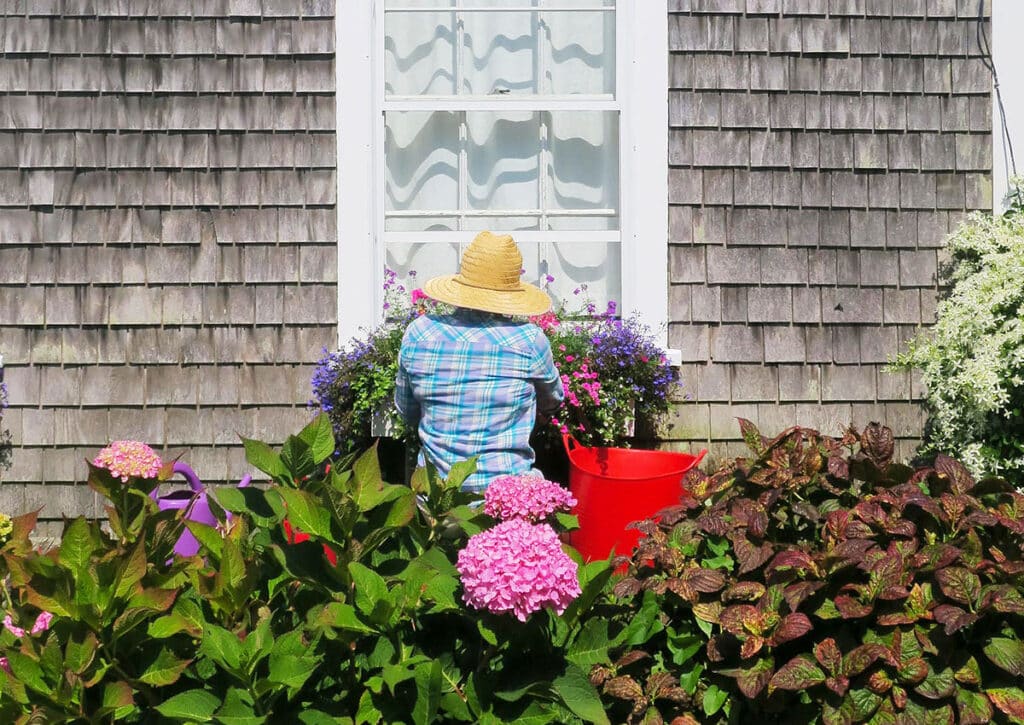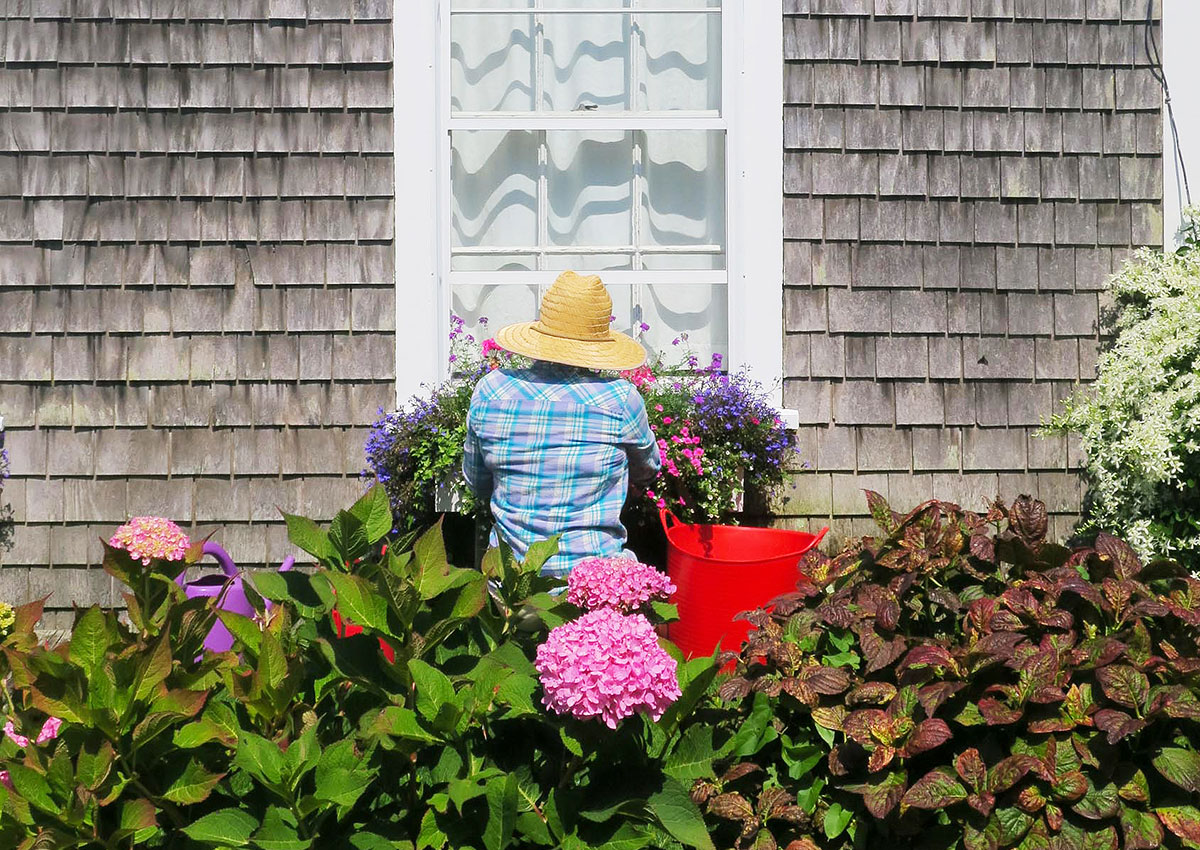by Greyson Keller
Summer exhales into autumn, and the leaves begin to turn,
The wind howls with some bite in its bark, as we embrace winter’s return.
But the sunny season is still firmly in our thoughts,
while we walk the garden at twilight.
Row covers cradle the ebbing crops, as we tuck in our harvests at night.
When morning comes, it delivers the dawn, and whimsy and wonder abound.
The fog rolls out and dew glistens on the lawn,
with gulls bellowing in the background.
A perfect setting for a moment in the garden, where the graft turns into grub.
Gather the veggies and beg for your pardon, for today we’re off to the golf club.

September is a time for reminiscence and reflection: time for all to take a collective exhale as we look back on the growing season. The pace has slowed and we turn our attention to gathering harvests and preparing the delicious comfort food of autumn.
I love September because we still enjoy warm days, the beaches have a bit more elbow room, and the roads begin to flow again. There are still plenty of tasks to be done, but, hopefully, we all have a bit more time for ourselves. Bike rides, dog walks, and surfing until sunset are all mind-clearing activities that mend our collective mental health.
During these crisp mornings, I enjoy a cup of tea sitting in the garden. I try to clear my head just take in the beauty of the veggies and flowers all working together. The amount of white butterflies I’ve seen this year in the garden is incredible. They’re a welcome sight, true animation in the garden. It makes you realize that all the hard work isn’t just for you. There is a whole community out in the garden, and they’re all working together. Each bug and bloom are doing their jobs to keep the ecosystem moving forward. Maybe our community and country could take a page out of their book. Working together for the greater good seems like sound logic, but sometimes can feel inconvenient. If we all endure a bit of inconvenience now, things might start to feel a little safer. People will be less triggered, and we can get back to the close-knit community we always have been. In the meantime, there are plenty of tasks to keep us busy in the garden.
In the landscape garden, the next couple of months are key to the continued development of your space. It’s a perfect time to dig and divide your perennials, plant trees, shrubs, and, of course, your spring bulbs. I’ve just ordered as many crocus bulbs as I could. My plan here is to carpet the front lawn with crocus blooms. It’ll be a sea of blue and white come March. To me, crocus are absolutely marvelous. They carry with them a briefcase brimming with hope. When I see their faces emerge from the frozen ground, sometimes through a blanket of snow, I can’t help but be filled with warmth and wonder. They’re a glimpse of what is to come. Spring has sprung and summer is sure to follow. Crocus are a great bulb for the lawn because they have their fifteen minutes of fame before we ever pull the mower out of the shed.
There are a few effective ways to plant bulbs. If you’re planting in a lawn, like I’ll be doing, an old fashioned bulb planter is best. It creates a core in the soil where you can just drop a few bulbs in and then snugly fit the core back in the hole. If you’re planting bulbs in a garden, there are attachments you can get for your household drill that will act as a mini-auger. This is super quick and efficient. Now is the time to be planting bulbs of all kinds, not just floral. You can also plant your garlic cloves for an early summer harvest.
Looking to other areas of the garden, if you have perennials or ornamental grasses that have outgrown their space like a 35-year-old child living in their parent’s basement, now is an ideal time to dig them up and divide them. The first step for me is to cut the plant back to the crown. If you’re dividing an ornamental grass, it can be a bit of a bummer to cut it back when the seed heads have begun their dance with the wind. It will, however, make the process much easier for you.
Once the plant is cut back and you have a nice, neat mound, it’s time for the digging. Try to start a fair distance away from the crown and work your way in. Most of the time a quality root ball will begin to show itself. Slice and lever, slice and lever all around the plant. Once it pops loose, now is the time to be brave. Take your spade and chop it right in half. This isn’t dainty or delicate. This needs sleeves rolled up to the elbow and a swift kick of the spade with some tightly-laced boots. If your plant is big enough, you might be able to divide it more than once. Now that you have several new plants, I always like to replant one of them back where they were planted. Then take the rest and disperse them in other areas in the garden. Another option is to pot them up and give them to a friend or family member. All that it cost you was a little sweat equity.
Once all your plants are planted or potted, always remember to give them a deep drink of water. They’ll thank you for it. I also recommend top dressing with a little mulch. It looks great, retains that moisture, and suppresses the weeds.
Let’s touch on the lawn areas of your landscape as well. September and October are great months to do some lawn maintenance. Aerating your lawn is an important step and will alleviate compaction. I like to do this along with dethatching. It makes raking the plugs up much easier. That way your lawn doesn’t look like a flock of geese have taken up residence. Dethatching also removes all the dead thatch that has built up over the growing season. This helps prevent fungus during the hot and humid months of summer. Once you’ve completed the aerating and dethatching, it’s a good idea to topdress with some nice compost or complete planting mix. Rake it into the lawn so it rests below the green blades of your grass, then overseed and water. If you’re one who likes a well maintained and healthy lawn, this’ll do the trick.
Just to chat briefly about our veggies we’ve been working so hard on all season, autumn will roll on and your cole crops will too. Things like broccoli, cauliflower, and kale all enjoy the cooler weather. It’s definitely advantageous to cloak them with a row cover at night to protect from frosts and winds. If you do this, you’ll be able to have fresh greens from the garden well into the holiday season.
For now, let’s remember to slow down and enjoy the change of season. Breathe deeply and take pride in your garden, no matter the size. Compliment your friends and family on their gardens and watch their faces light up with pride. Remember how eager everyone was to get them started this spring and remember the work that went into them. It’s effortless and doesn’t cost a thing to give a few words of encouragement, whether or not they’re about a garden.



